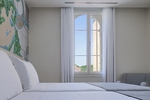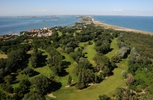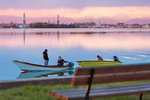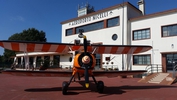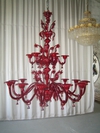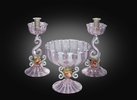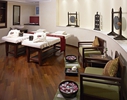Hotel Ausonia Hungaria
Linda Fornara Bertona
Hospitality and Art
Venice’s Lido island, home of famous "Mostra Internazionale d’Arte Cinematografica" since 1932, is an interesting little island in Veneto Region. For millennia, the nature and traditions of Venice’s Lagoon have been attracting thousands of visitors. The history of Ausonia Hungaria Palace is interwoven with that of Venice’s Lido island, as the favourite destination of well-known visitors. www.ausoniahungaria.it
The name Ausonia Hungaria spans the full history of this hotel since it opened in 1907. Originally called the Hungaria as a tribute to the Hungarian guests who frequented the Lido island, the hotel retained this name until the 1920s when it was renamed Ausonia, the ancient Greek name for lower Italy.
The aspiration to be an iconic and distinctive feature on the landscape of the Lido characterized the palace from 1913 when the ceramist Luigi Fabris created the distinctive decoration of the main façade in multi-coloured majolica tiles, giving the island a unique building in Liberty style.
After different managements, in February 2007 the hotel was acquired by its current owner Teodoro Russo, who commissioned the grand restoration works of the prestigious building. Covering the entire financial commitment and in close liaison with Venice’s Architectural Heritage Office, Teodoro Russo’s project implemented a tasteful and full renovation of the building’s interiors and exteriors.
The repair of 7,000 majolicas decorating the main façade, completed in about 4 months, used advanced restoration techniques along with the great devotion to the unique type of work, which was as unique as the subject of renovation itself. Additional and resources where invested in enhancing the building again with the results speaking for themselves, as Ausonia Hungaria stands today as the most unexpected 5-star luxury hotel in Venice.
With an outstanding mix of past and present, the eclectic British pop-artist Joe Tilson created the covering of the east façade by applying polychrome tiles in Murano glass.
The 60 rooms and suites evoke the distinctive mix of history and innovation that characterizes the Ausonia Hungaria. By combining the precious design of the contemporary furnishings by architect Simone Micheli with prestigious details of the building’s façades, the fine adaptations give life to an alluring blend between the internal and external spaces.
The prestigious Lanna Gaia Thai centre is a temple wellness. Covering some 600 sq.m, it is open for all visitors to Lido island and offers a wide range of holistic treatments to relax and rejuvenate mind, body and soul. The high-skilled therapists from the Lanna Thai Academy of Bangkok perform traditional well-being massages to provide the precious benefits of Thai tradition.
The hotel can be a starting point for fascinating excursions, Venezia in primis. But you can quickly reach the Burano Island, famous for its lace and Murano, famous for its glass making. The origins of glass art in Venice are very ancient. You can see the "glass art" of famous masters at the Bisanzio Gallery.
For helicopter lovers, it is possible have a personal trip to discover Venezia and Veneto Region. Giovanni Nicelli Airport is located in the Northern part of the island just ten minutes by boat from the city center. The air terminal, an example of preserved architecture, inaugurated on 4 February 1935, is the oldest trading post in Italy.
Before leaving the island you can visit Malamocco, the first and the only settlement on the Lido of Venice barrier island. It was the location of the original home of the Doge of Venice. Malamocco also refers to one of the three narrow channels in the barrier island chain that separates the Venetian Lagoon with the Adriatic Sea. In Malamocco you can find peace and beautiful sunsets. Copyright Deluxu.it Magazine
27/08/2019




